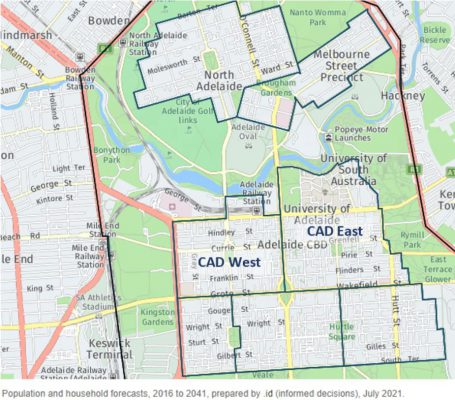Purpose-built student accommodation is changing the fabric of many of our CBDs. Last month our Local Government Population Forecasting Team reviewed population forecasts for the City of Adelaide and were surprised with just how big an impact the sector is having in the Adelaide CBD.
In this blog, Andrew Rossiter shares some of what the team learned on the current state of purpose-built accommodation in Adelaide, including the impact of the pandemic on current occupancy rates and what the road to recovery may look like.
Background
A few years ago we prepared population forecasts for the City of Adelaide, and I was surprised with the impact international students were having on the CBD. This time what stood out was just how much purpose-built student accommodation (PBSA) was being built to house this culturally diverse group.
Fast forward to last month when we revisited our population forecasts. We found that due to COVID-19, the anticipated growth in students living in PBSA has taken a massive u-turn.
What exactly is purpose-built student accommodation (PBSA)?
PBSA is housing specifically designed and built for students by commercial developers. PBSA includes studios and shared apartments with communal living spaces.
Unlike traditional university halls, PBSA developments are popping up in locations across all CBD areas. They’re traditionally very popular with international students, as they are located close to retail, entertainment, transport and the whole host of services and facilities offered by CBDs.
Pre-pandemic and current forecasts
Back in 2019, PBSA was beginning to boom in Adelaide, with the numbers of students living in PBSA almost doubling over the five years to 2016. Over this time, almost one-in-three (31%) of ALL new residents to the City of Adelaide chose to live in PBSA. This was up from 9% between 2006-2011, and just 2% between 2001-2006.
And back then we expected the boom to continue, with people living in PBSA to double again to 2020, contributing 33% of total population growth in the City.
What actually happened was that instead of doubling, due to COVID-19, students in PBSA actually declined compared to 2016, representing -6% of total population growth in the City of Adelaide.
We gathered this information by speaking with each of the PBSA providers to hear first-hand what the impacts of the pandemic had been on their occupancy rates, as well as their outlook on the future.

Growth in people student accommodation as share total population growth, City of Adelaide, 2001-2020
What did the providers say about the current situation and what is their outlook?
First of all it’s important to note the PBSA developments previously forecast have actually been built. The problem is that they are now largely unoccupied due to COVID-19 and some international students either returning to their home country, or simply not coming to Australia.
The chart below shows this recent jump from around 2,000 beds in 2016 to almost 6,000 beds now!
This includes some big developments, including three developments, with 2,300 beds between them which were built in the past 18 months. Sadly, we learned from these providers that they currently sit unoccupied with opening dates being pushed back.
You can see the overall impact of the pandemic on student accommodation occupancy (beds) in the chart below, while the following chart shows this impact expressed as an occupancy rate (%).
Student accommodation, total number of beds, City of Adelaide, 2001-2041

Occupancy, Student accommodation and private dwellings, City of Adelaide, 2001-2041

It’s clearly devastating for PBSA in the City of Adelaide with current occupancy across the City at 40%, compared to 84% for private dwellings. That’s a total of almost 3,000 empty beds and fewer students across the City than would otherwise have been.
And this is not unique to Adelaide, we know the impact on international students is being felt in most CBD areas in Australia. This article and interview with co-founder of Scape Australia, the country’s biggest PBSA provider, sheds more light on the state of the sector with Scape’s national portfolio currently sitting at just 25% occupancy.
What is encouraging is that, according to many industry experts, the long term outlook remains bright. With our world class universities and quality of life, the pull factors for international students to live and study in Australia are solid. It’s just that we are unlikely to quickly snap back to pre-pandemic levels.
You can see how we’ve forecast this recovery for the City of Adelaide with a timeframe of 7 years for the current PBSA stock return to occupancy of around 90%. This is of course dependent on how quickly Australia can safely reopen its borders to the rest of the world. And in the meantime initiatives like the International Student Quarantine Hub in Adelaide, will bolster these efforts
Where is the development happening?
PBSA development is concentrated in the two small areas (CAD West and CAD East) which is the commercial core of the CBD, and where both the University of Adelaide and University of South Australia campuses are located.
The small area map below can be found on the City of Adelaide forecast.id website here .
Forecast areas, City of Adelaide, 2001-2041

To ensure our forecast assumptions are clear and transparent, the table below shows the detail of where we forecast the growth to occur. It can be found on the City of Adelaide forecast.id website here.
You can see that the CAD East small area is forecast to accommodate the majority of growth in people in PBSA in the City of Adelaide, with an extra 2,500 students in PBSA by 2041. That’s 63% of total growth across the City of Adelaide and is a big shift in that part of the City, where, in 2016, there were fewer than 200 people living in student accommodation.
This will mean that over coming years CAD East will have a very different ‘feel’ as the PBSA starts to fill up with international students each bringing their own unique cultural diversity.

What’s next
Population forecasting in the pandemic is challenging with new information coming-to-hand almost daily.
We are continually refining our assumptions to reflect the most likely outcome based on all of the information available at any given time.
We also regularly monitor the performance of our forecasts which we share with our Local Government clients. This allows us to respond to change faster in forecast areas that are impacted by changes in the underlying assumptions.
And of course we are also looking forward to the 2021 Census results next year which will provide us with the best data to check our forecasting assumptions and recalibrate our forecasts!














